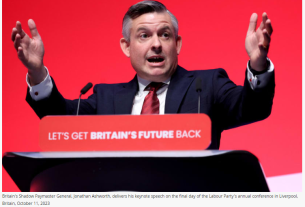|
Getting your Trinity Audio player ready...
|
The passenger planes of today are based on designs that have been fundamentally the same for decades. This means that flight times have also changed very little.
But what if people could get from Paris to New York in less than one hour?
Sky-high ambitions
That’s what the EU-funded STRATOFLY project proposed: a Mach 8 airliner – a hypersonic aircraft that can go at least 9 500 kilometres per hour, or about eight times the speed of sound.
‘It’s going be a real challenge,’ said Nicole Viola, who coordinated STRATOFLY and is a professor at the Polytechnic University of Turin in Italy. ‘Maybe we’re not ready yet for Mach 8 right now. But I’m sure that I will see a hypersonic airliner in my lifetime.’
A three-year initiative that began in 2018, STRATOFLY designed a prototype for a hydrogen-powered hypersonic aircraft able to carry 300 passengers.
Ambitious ideas like this one are entering the world of civil aviation once again. New designs, technologies and fuels are being explored to make aeroplanes fly faster, soar higher and have a smaller environmental footprint.
While these technologies might take decades to enter service, it’s important to dream big now, according to scientists.
Not so fast
The STRATOFLY design came with plenty of technological challenges. But one of the biggest sticking points wasn’t so much to create an aircraft that could fly fast but rather to design one that could also fly slowly.
‘The challenge isn’t in the hypersonic phase,’ said Viola.
The hypersonic airliner that Viola and her colleagues dreamed up would need not only to fly at high speeds but also to take off and land at much lower velocities.
“
I’m sure that I will see a hypersonic airliner in my lifetime.
This produces design challenges. An engine capable of hypersonic speeds, for example, isn’t the best option for lower speeds. A hypersonic engine also needs a huge inlet to “breathe in” air, which gets mixed with hydrogen.
‘As the speed grows, the inlet grows as well,’ said Viola.
But at a lower speed, less air needs to get sucked into the engine. This requires scientists to make a compromise in the design.
The 94-metre aircraft contains a massive inlet in the nose, with sliding doors to regulate the air intake.
From take-off to a speed of around 5 000 kilometres per hour, six smaller engines do all the work. Above that velocity, one massive engine extending along the tail thrusts the aircraft forward.
Back to the future
The STRATOFLY proposal is only a concept designed to demonstrate what a hypersonic airliner could look like. It allows researchers to test and think about new technologies that might take decades to build successfully.
Today, however, the aviation industry might be returning to supersonic airliners like the famed Concorde, which was in service for more than 30 years before being retired in 2003. Used by Air France and British Airways, the Concorde was best known for its Paris-New York and London-New York routes featuring one-way travel times of three to three-and-a-half hours.
Boom Aerospace, a US company, has already signed contracts on supersonic design with United Airlines and American Airlines.
And hypersonic flight is attracting attention beyond civil aviation. The space industry is eyeing the technology to build craft that can take off like a plane, a development that could reduce the need for expensive rocket launches.
‘Hypersonic is somewhere between aviation and space,’ said Viola. ‘So, eventually, we will see one of those fields take up the technology.’
Clearing the air
If such high-speed flying eventually becomes possible, a related goal is to limit the environmental impact. Today, aviation accounts for around 2.5% of global CO2 emissions, a percentage that risks rising with faster flights.
Hydrogen might be the solution here, according to Professor Bobby Sethi of Cranfield University in the UK.
‘We have been researching hydrogen for aviation for a long time,’ Sethi said. ‘The costs, however, have long dampened enthusiasm. But its introduction is a question of when, not if.’
“
Invest aggressively in hydrogen to reduce the transition time.
He coordinated the EU-funded project ENABLEH2, which examined the potential of hydrogen in aviation over four years through last November.
There is much to like about hydrogen, according to Sethi.
It is one of the most abundant elements on Earth and, if generated with renewable energy, emits no CO2. In addition, the ENABLEH2 research showed that hydrogen combustion systems will deliver lower emissions of NOx, another greenhouse gas, than kerosene.
Furthermore, aircraft powered by hydrogen can fly longer distances than electrified planes, which will likely be used only for short to medium-range flights.
Transition routes
But then there are the costs. Hydrogen behaves differently than regular aviation fuel, so planes and some airports would need to be completely redesigned – a transition that could take around 20 to 30 years, according to Sethi.
‘We could technically redesign an existing aircraft, like an Airbus A380, to use hydrogen,’ he said. ‘But you would need to install hydrogen tanks in the aircraft. We can’t just store the fuel in the wings as is done now, which makes the model uncompetitive with regular fuel or sustainable aviation fuels.’
That’s why most predictions foresee an intermediate period when the industry uses alternative sustainable aviation fuels (SAF), which are generally made from sources such as biomass or waste and produce less life-cycle CO2 compared with regular jet fuel.
According to Sethi, however, that might not be the right way to go. He says SAF could delay investments in hydrogen.
It would be better, according to him, to focus on carbon capture of aviation emissions in the intermediate period and ‘invest aggressively in hydrogen to reduce the transition time.’
Regardless of the path taken, the key for Sethi is a long-term and sustainable future for the industry.
‘Aviation has enormous social and economic benefits,’ he said. ‘It has lowered transport times across the globe drastically and has been a driver of economic growth through, for example, tourism. We can’t let that be destroyed.’
Research in this article was funded by the EU. If you liked this article, please consider sharing it on social media.



